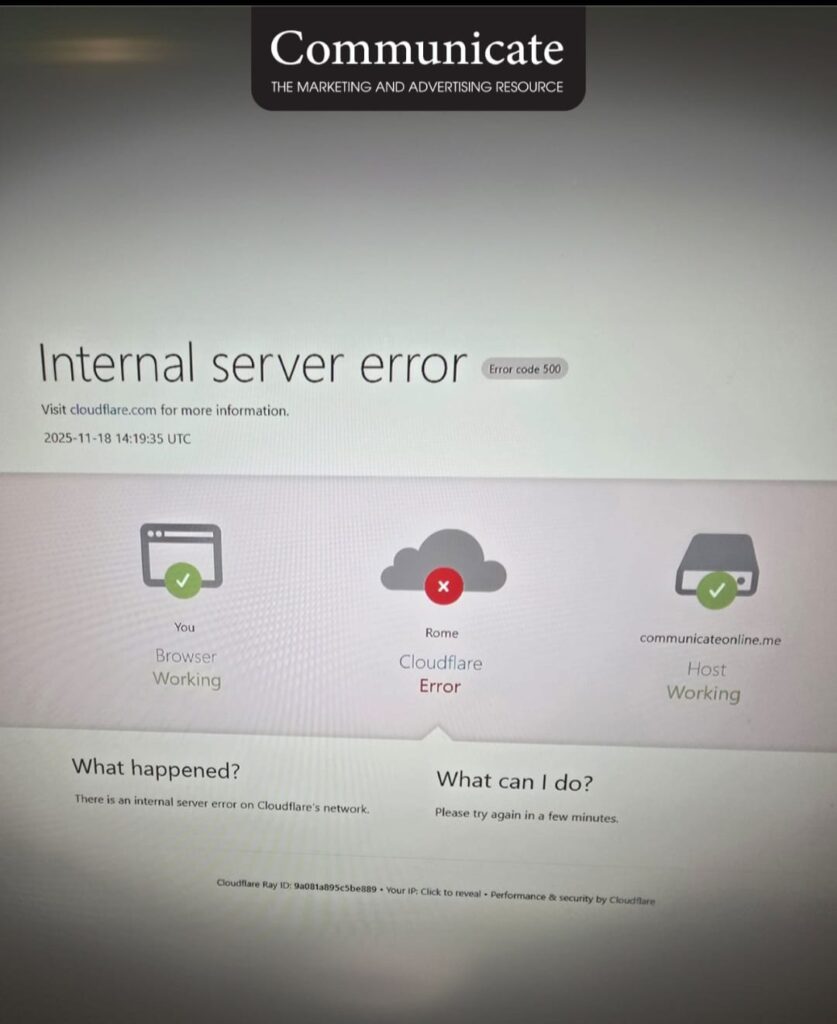Socialbakers provides an analytical look at the growing importance of customer experiences and the data in paid, organic, and influencer marketing that marketers need to know to deliver stellar CX in 2021. The report also details some developments in influencer marketing, including the hashtag – #ad usage and which type of influencers have increased their interactions compared to last year.
Consumer Expectations and the CX Gap
The importance for brands to deliver outstanding digital customer experiences (CX) only continues to increase. One study discovered that 74% of customers today are likely to buy based on experiences alone. But the ability to keep up with the consumer's needs, expectations and preferences from their brand experiences on all channels, including social media is a real challenge. Data from Forrester shows a moderate correlation between how well brands meet customer expectations and the quality of their overall CX.
Social media now holds a critical place in the customer journey both pre and post purchase. eMarketer predicts social commerce will continue to expand in 2021, increasing 12.9% YoY to reach 90.4 million US consumers who purchase at least once via a social channel whether it's Facebook Marketplace or Instagram checkout.
Empathy on social media will play a big role in 2021. Walking in consumers’ shoes – to empathize with their needs every step of the way – remains essential to delivering experiences customers crave on digital channels like social media. Insights from the survey states that 84% of surveyed B2B leaders feel the pandemic has enabled them to become more empathetic to their customers’ needs (vs. 49% for B2B laggards). Simulatenously with empathy, being able to quickly (or automatically) escalate issues and questions shared on social media to help ensure quick responses will play a key role in driving positive CX via social channels.
The Paid Social Media Trends
Majority of budgets were shifted to online media in 2020 as it was the only way to reach consumers and based on the data from Socialbakers, it's only going to be continuing in this trajectory this year. In Q1 2021, marketers spent 60% more on Facebook and Instagram advertising compared to Q1 in 2020. We are likely to see the uptrend continue as the world reopens after the pandemic lockdown and businesses ramp up spending to reach consumers – especially in sectors that, due to circumstances, were not able to provide businesses or services during this time.
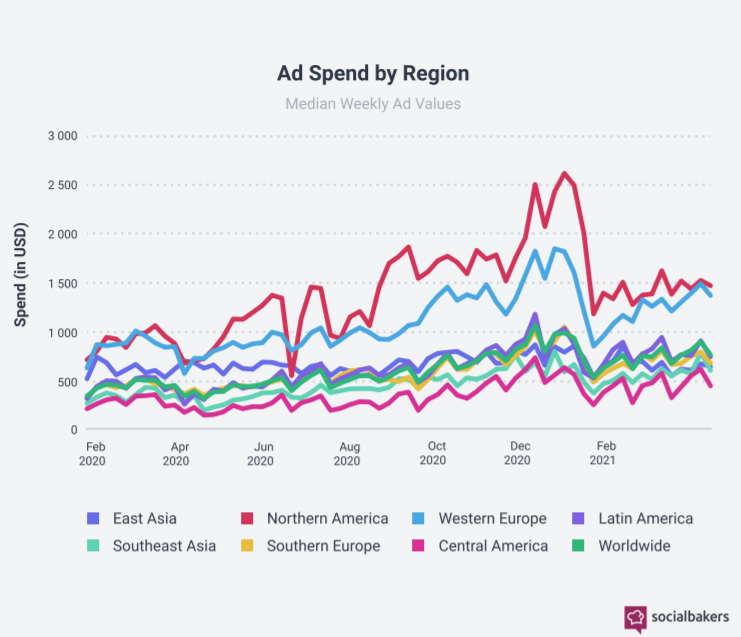
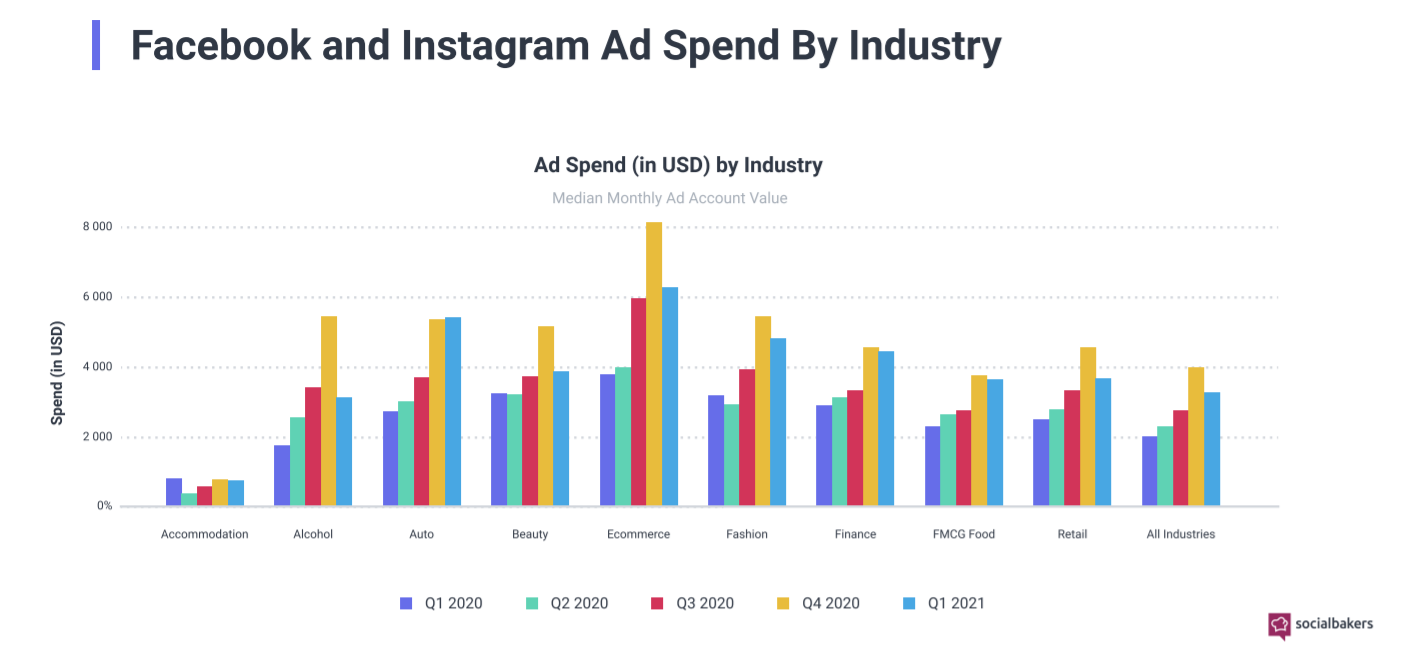
With total Facebook and Instagram spend reaching new highs this year, the overall worldwide costs to advertise grew by 37% in Q1 2021 compared to Q1 2020. The growing advertising costs signal higher competitiveness among advertisers and future success will be increasingly more dependant on the expertise, advertising tools, and the accuracy of data advertisers use.
Since the global coronavirus pandemic started, both total advertising spend and costs have been increasing; however, what remains stable is the click-through rate that Facebook and Instagram ads return. This trend suggests that businesses can depend on social media advertising to return value even if other channels seize to work. It points to the resilience of social media advertising and the effectiveness of the app algorithms to find the right people that will engage with your business and will yield positive advertising ROI.
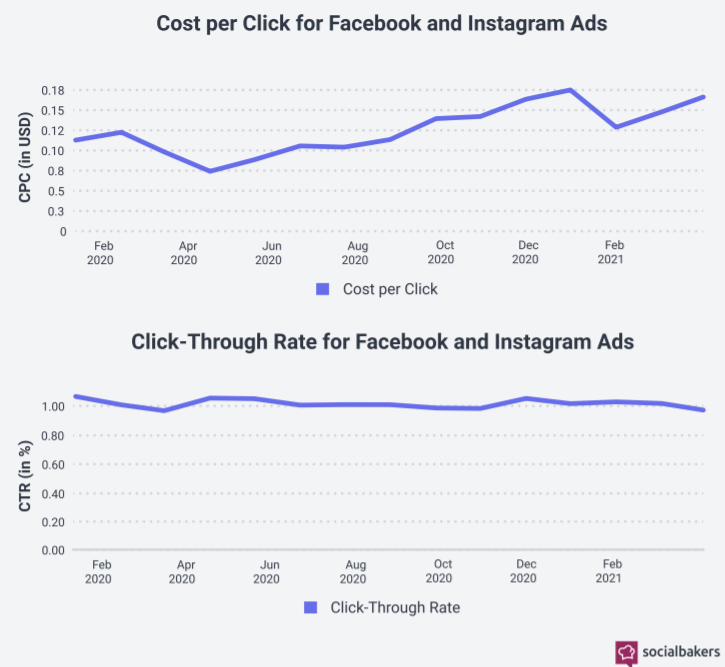
Reach is arguably one of the most important metrics marketers have to watch when it comes to Facebook advertising. Overall, reach has been growing significantly over the course of the last year. Advertising reach is a key indicator not only for marketers, but also for Facebook growth, as additional users that can be reached through Facebook advertising are a revenue source for the company itself. COVID brought an immense amount of changes to the customer experience landscape and altered behaviors for the long run. The increasing ads reach may be a reflection of both, the rise in Facebook ad spend as highlighted on previous pages, but also a mirror of a change in user behaviors.
In Q1 2021, Facebook reach has slowed in growth, but still expanded by 8% compared to Q1 2020.
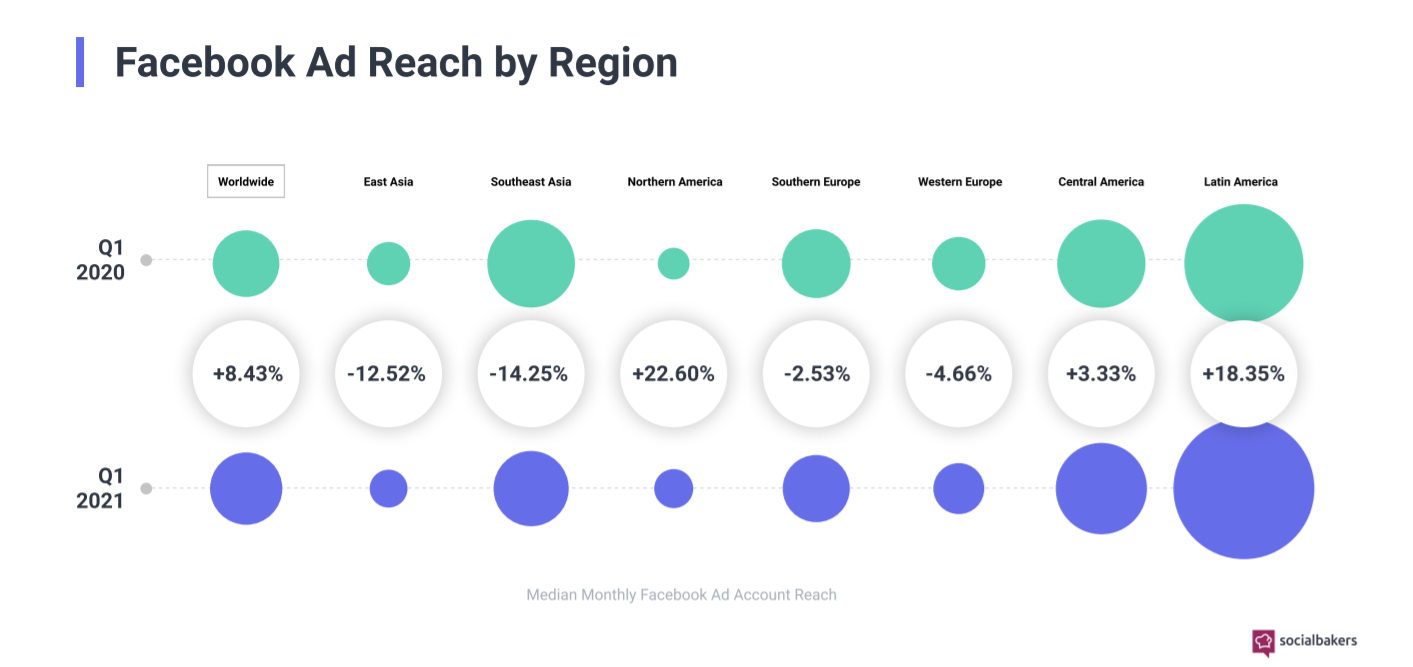
While Facebook has been actively seeking to increasing advertising space on its platform, the majority of spend is still allocated to the Facebook News Feed. The Facebook News Feed placement also returns the best CTR at 1.8% on average. That’s significantly higher than Instagram Feed placement (0.3%). According to Socialbakers data, more than half of the advertising revenue is generated from the Facebook News Feed. The Instagram Feed, the second most popular placement by spend, is trailing behind at just 16% of total allocated ad spend by marketers, while Instagram Stories gathered just over 9% of total spend in Q1 2021.
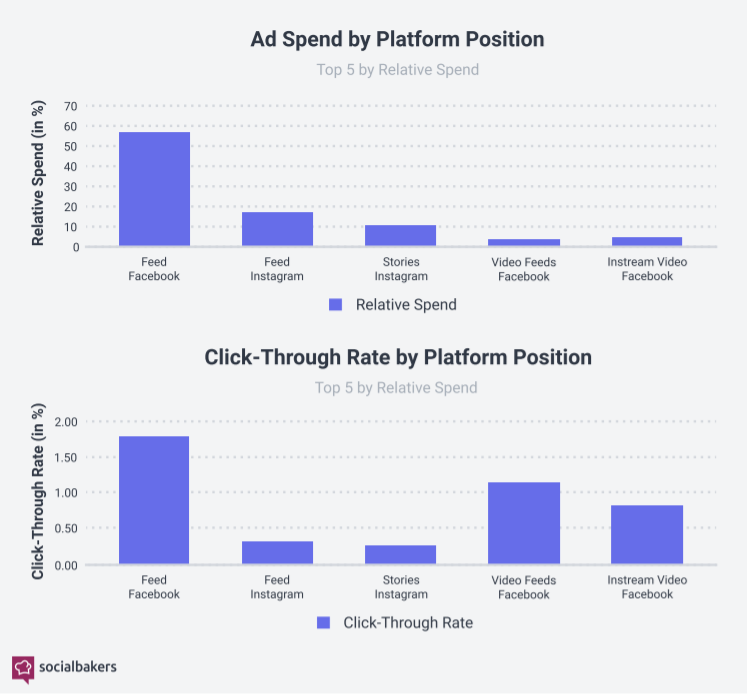
In Q1 2021, the total audience size of the 50 biggest brand profiles was 40.3% bigger on Instagram than Facebook. Looking at YoY results, Instagram’s audience grew by 10.3% compared to Q1 2020 while Facebook’s audience basically remained the same, increasing by 0.8%. Engagement remained significantly stronger on Instagram, which had 22.7x more interactions than Facebook, while 53.7% of all brand posts were on Facebook.
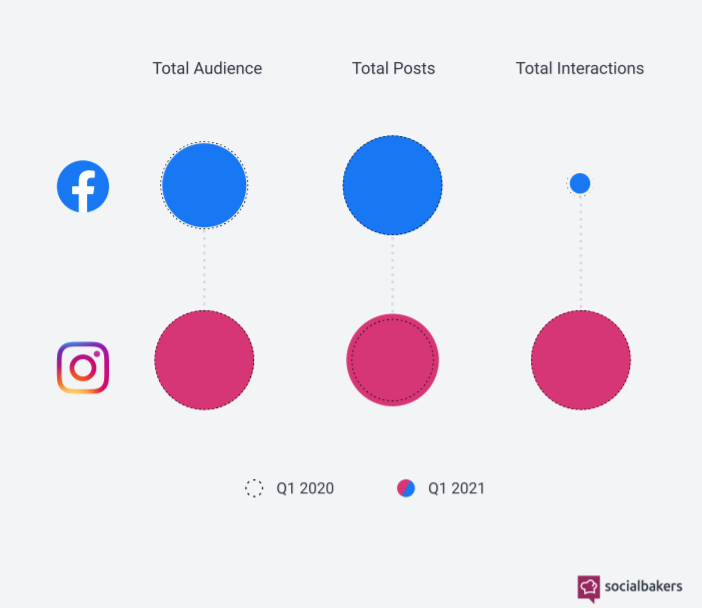
Over the last 15 months, the relative post interactions for the 50 biggest brand accounts on both Facebook and Instagram were at their lowest in Q1 2021. Instagram interactions had been relatively steady through most of 2020, but started to decline at the end of the year. On Facebook, a sharp uptick at the beginning of the pandemic skewed the rest of the data, but experienced a gradual decline.
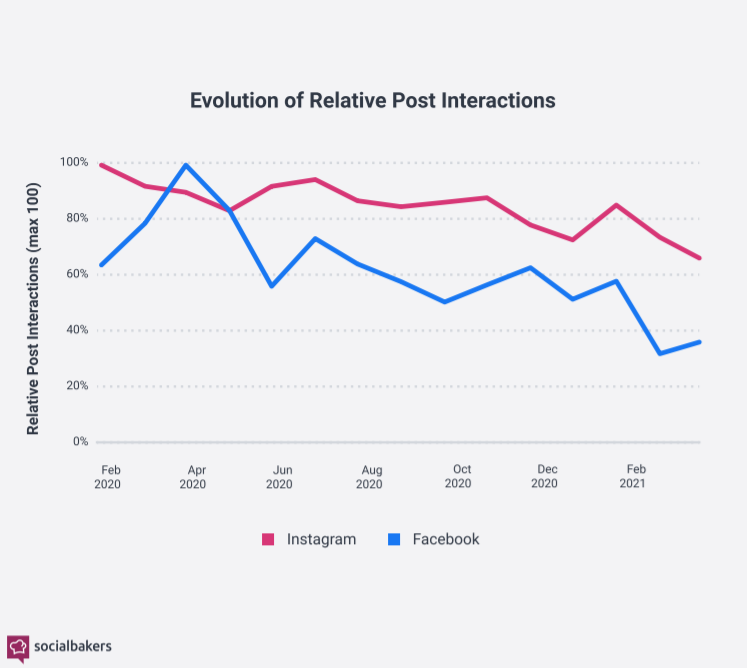
According to Socialbakers data, in Q1 2021, Facebook Live was by far the most engaging format on the platform with 42 median post interactions. On Instagram, carousel was the most engaging format with 182 median post interactions. Carousel posts, which can contain both images and videos, have consistently outperformed image and video. Compared to Q4 2020, most of the formats remained relatively stable. Facebook Live and carousel on Instagram increased slightly, while the others remained basically the same or decreased slightly.
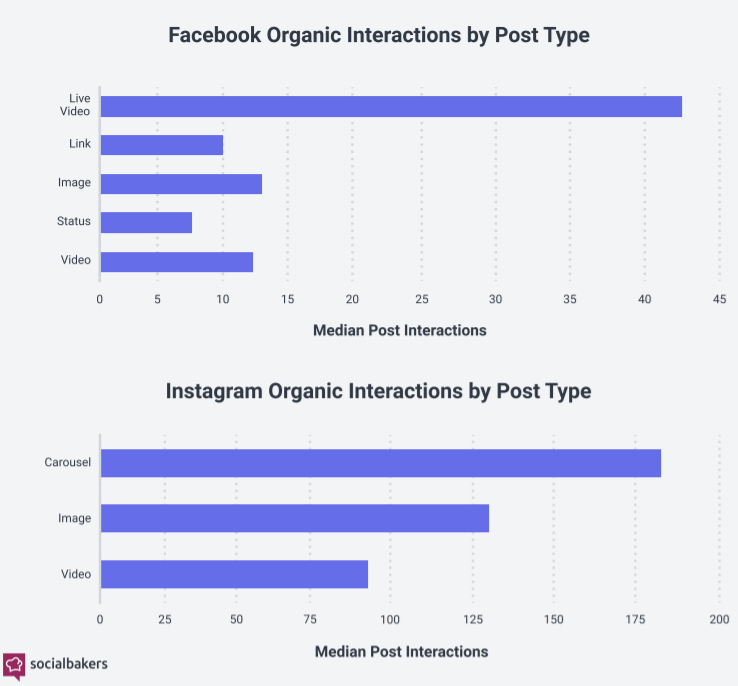
The Live Commerce Trend
The emerging trend of live commerce is arguably the largest new development in the way businesses transact with consumers using social media. The trend was skyrocketed by the changes in user behaviors during the COVID-19 pandemic that made it necessary for businesses to provide alternative shopping experiences to consumers. This type of a shopping interaction provides an end-to-end user experience all the way from product discovery through video and live content to purchase through automated or personalized messaging.
Facebook Live Industry Trends
According to Socialbakers data, more than a quarter of Gambling pages on Facebook – 27.2% – went live at least once in Q1 2021. That was the highest of any industry, followed by Telecom (19.4%) and Electronics (17.8%).
However, Beauty and Ecommerce, which are two industries that pivoted well to the digital landscape in the pandemic, received some of the most comments on their live videos compared to overall interactions. For Beauty, 36.8% of interactions on live videos were comments, followed by Gambling (32.8%) and Ecommerce (31.1%)
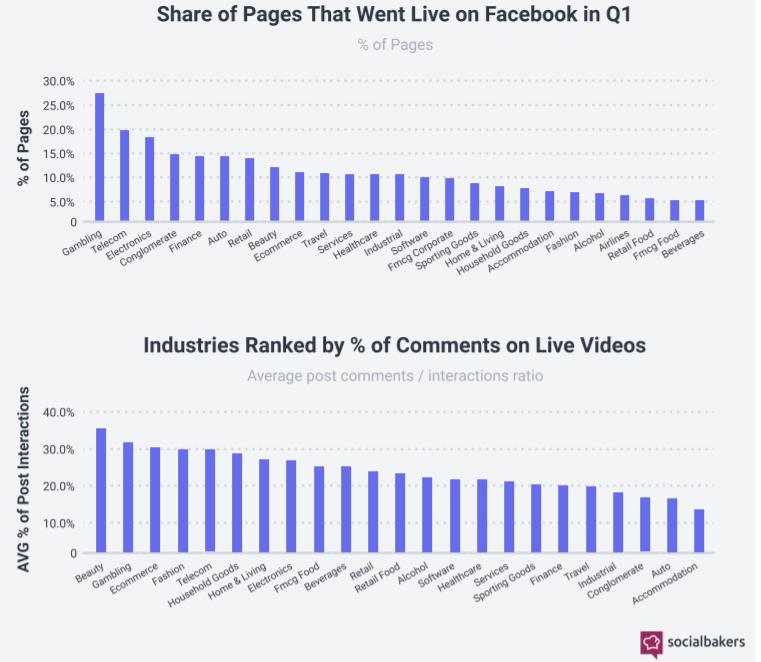
According to Socialbakers data, worldwide media posts with no hashtags on Instagram had nearly double the amount of median interactions as other posts that did use hashtags. However, when looking at worldwide brand accounts on Instagram, posts with 1-2 hashtags were slightly ahead of those with 3-4 or no hashtags. What’s consistent in both cases is that throwing on a bunch of hashtags is not an effective strategy. Social media managers should avoid tacking on unnecessary hashtags in an effort to gain more traction as data shows that it just doesn’t work.
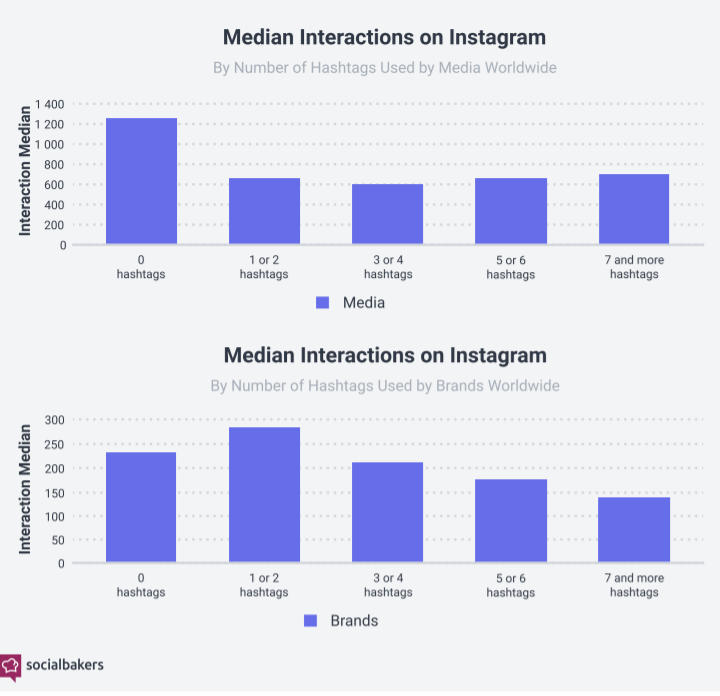
According to Socialbakers data, posts with less than 100 characters received the highest number of median interactions. While there wasn’t a huge disparity in performance among the various lengths – the overall median was 257 – the data suggests that short and very long Instagram posts performed the best.

In Q1 2021, the number of Instagram influencers who used #ad in their posts decreased by 14.9% compared to Q1 2020.
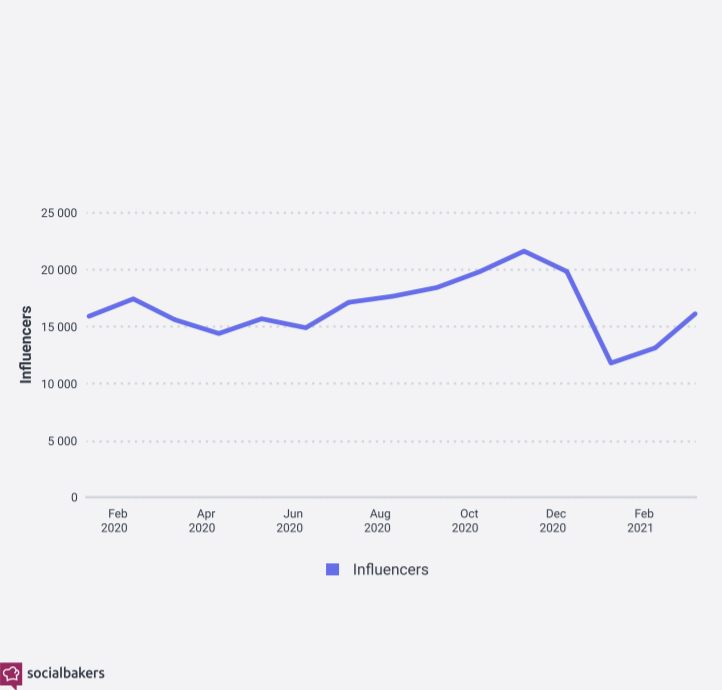
The data in this report offers some advice for marketers to factor into their overall social media strategies. While not necessarily surprising, the large growth of interactions on E-commerce content on both Instagram and Facebook is likely a harbinger of the way consumer behavior has changed during the pandemic.Now that this behavior is ingrained, many consumers will incorporate those choices going forward because of the improvement in the social commerce experiences, which makes it not only possible but easy to search for, select, and purchase an item all within the app.
This means that your digital experience needs to keep pace with the expectations that are coming from your audience. That includes more robust chatbot capabilities, a strong social commerce experience, and social listening and monitoring to stay on top of your audience’s wants and needs.


